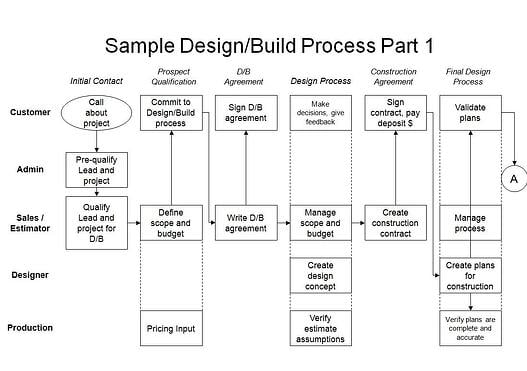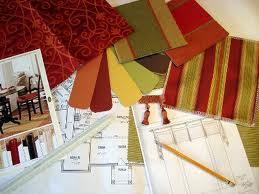Four Considerations for Contractors Offering Design - #4 is Most Important!
 With a well thought out strategy for offering design services contractors can differentiate their businesses and attract better quality clients and projects. However if their offering is not well thought out contractors can lose a lot of money and waste a lot of time.
With a well thought out strategy for offering design services contractors can differentiate their businesses and attract better quality clients and projects. However if their offering is not well thought out contractors can lose a lot of money and waste a lot of time.
If you want to offer design services consider these four important areas before you go for it. If you are already offering design services, these same considerations can help you validate and or think a bit more strategically about your offering.
#1: Compensation
Nothing is free, neither is design. Even if you offer it for free to prospects doing so still adds to your business overhead costs. Charging each customer for their design is one option. If you don't charge consider how many free designs you will complete to sell one job and add the anticipated costs for doing them to your overhead budget before you determine your markup. How you choose to go forward with this consideration should be based on the targeted customer type you identify in your marketing plan.
Offering design comes with risks. I also strongly recommend getting Design Liability Insurance and adding the cost of coverage to your pricing strategy.
#2: Create a clearly defined process
To control costs and manage customer expectations you need to decide what level of service you will offer, and whether you will offer your design services at a fixed price or on an hourly rate. At my business I used a fixed/defined process and price strategy limited to concept design. This was because as a Design/Builder our goal was to quickly get to a contract for construction. Completing the plans for permit application only happened if we built the project. For our target customer type that process worked well and kept the upfront cost of making decisions and getting to a fixed price quote down for our clients.
The image below shows the first half of the Design/Build process I share with my clients.

#3: Ownership of the plans
Consider whether you are selling design services or plans. If you sell plans your clients may see their project as a commodity and may want to use those plans to collect bids from other contractors. Allowing that to happen also definitely increases your design liability. My recommendation is to differentiate your business by selling personalized design services, not plans. Then, only offer design services to prospects who intend to hire your business to complete the project. Plans for permit can then be created and shared with them after they commit to construction.
 #4: Use a supporting marketing and sales strategy
#4: Use a supporting marketing and sales strategy
After thinking through and deciding on the considerations mentioned above the business will need a way to market and sell their offering. The right marketing should help define your offering so prospects can prequalify whether what you offer is right for them, or not. Doing this will help attracted your targeted prospect and save salespeople a lot of time on sales calls. This is because by doing so prospects will only need to clarify and confirm your offering when they request to meet or speak with you, you will no longer need to introduce and explain your offering.
Your web site is a great tool to use for marketing and explaining your design services. And, if the information is on your web site, you can direct prospects to it from the other marketing tactics you use, or when they first call your office to inquire about a project that requires design.
Other Design related articles you might find helpful
Managing Risks With The Right Design/Build Insurance Options
Design and Spec Considerations for Remodelers Looking to Break $1Million
All Plans and Specifications Will Be For The Exclusive Use Of …
As Designers, Are We Honest in our Business Dealings?
10 Ways Some Architects Do A Disservice To Contractors & Home Owners
Design Options for Design/Builders: Partnering for Design
Design Options for Design/Builders: In-House Design



 As a contractor, you know that building a custom home or doing a major remodel is not a one-person job. You need to work with an architect, an interior designer, one or more sub-contractors and any number of laborers—and, of course, the homeowner. Getting everyone on the same page can be the difference between an amazing house and a patchwork disaster.
As a contractor, you know that building a custom home or doing a major remodel is not a one-person job. You need to work with an architect, an interior designer, one or more sub-contractors and any number of laborers—and, of course, the homeowner. Getting everyone on the same page can be the difference between an amazing house and a patchwork disaster. In a
In a  Most contractors do not have a licensed person on their team who can handle all the components of a construction job. For roofing, foundations, plumbing and electrical, they will usually subcontract to a licensed professional and or expert. In many cases, the interior designer may be a subcontractor of the lead contractor, making him the designer’s de facto boss. Whichever way you structure the construction process, you have some
Most contractors do not have a licensed person on their team who can handle all the components of a construction job. For roofing, foundations, plumbing and electrical, they will usually subcontract to a licensed professional and or expert. In many cases, the interior designer may be a subcontractor of the lead contractor, making him the designer’s de facto boss. Whichever way you structure the construction process, you have some 
 If your goal is to grow your remodeling business past the $1Million installed sales volume threshold the business will need a design and or specification process. That process must support the ability to perform a "handoff" between the salesperson and the production team that will build sold projects. Without adequate plans and specifications the production team and a project's lead carpenter will be constantly contacting the salesperson for the information needed to build what the customer is expecting.
If your goal is to grow your remodeling business past the $1Million installed sales volume threshold the business will need a design and or specification process. That process must support the ability to perform a "handoff" between the salesperson and the production team that will build sold projects. Without adequate plans and specifications the production team and a project's lead carpenter will be constantly contacting the salesperson for the information needed to build what the customer is expecting. Be honest not only to your customers, but also with yourself. I fortunately recognized very early in the building of my business that I was not a designer. I can build any design you give me, I just don't have the right talents to design renovations at the level my target customer expected and deserved. So, if you do offer or plan to offer design services make sure you find the right talent to do so. That person
Be honest not only to your customers, but also with yourself. I fortunately recognized very early in the building of my business that I was not a designer. I can build any design you give me, I just don't have the right talents to design renovations at the level my target customer expected and deserved. So, if you do offer or plan to offer design services make sure you find the right talent to do so. That person  First, make sure you can legally offer design service where your business operates. Next, make sure you and or your employees have the right construction, product and building science knowledge and experience to offer design and or specification assistance. Value engineering for a prospect may help you sell a project, but what if you suggest or substitute products that compromise the design, the structure and or the purpose of the project? You may own the end result and it could cost you a lot of money.
First, make sure you can legally offer design service where your business operates. Next, make sure you and or your employees have the right construction, product and building science knowledge and experience to offer design and or specification assistance. Value engineering for a prospect may help you sell a project, but what if you suggest or substitute products that compromise the design, the structure and or the purpose of the project? You may own the end result and it could cost you a lot of money.  This may seem like an obvious point but here me out. If your goal is to bust past $1Million your plans and specifications should include not just what might be needed to sell the job and or get a permit. Your plans and specs should really be communication tools that your production team will use to build from. Measurements, product sizes, rough opening dimensions, center lines and clearances all become critical when building, and even more critical if you want to protect your margins and project schedules. With the right plans and specifications you can protect your profits and only have to build the project once.
This may seem like an obvious point but here me out. If your goal is to bust past $1Million your plans and specifications should include not just what might be needed to sell the job and or get a permit. Your plans and specs should really be communication tools that your production team will use to build from. Measurements, product sizes, rough opening dimensions, center lines and clearances all become critical when building, and even more critical if you want to protect your margins and project schedules. With the right plans and specifications you can protect your profits and only have to build the project once. As produced volume increase for a remodeler, that remodeler must decide between being a contractor and a construction business owner. As a contractor you can do all of the above yourself, but breaking $1Million will be challenging, require lots of work hours and may not be practical depending on your target project types. As a construction business owner your role will be to profitably run the business not the jobsite. If that is your goal make sure your team members will be creating the information each department needs to successfully sell profitable projects and perform their assigned responsibilities.
As produced volume increase for a remodeler, that remodeler must decide between being a contractor and a construction business owner. As a contractor you can do all of the above yourself, but breaking $1Million will be challenging, require lots of work hours and may not be practical depending on your target project types. As a construction business owner your role will be to profitably run the business not the jobsite. If that is your goal make sure your team members will be creating the information each department needs to successfully sell profitable projects and perform their assigned responsibilities.

 The architect either invites multiple contractors to bid on the project or gives the homeowner the names of 5 (or more) contractors to bid on the project, essentially setting up an auction. So 5 contractors and all their subs do free estimates for the chance to be the lowest bidder (biggest loser). Then when the home owner actually buys from a contractor they are the ones paying for all the free estimates that contractor did for the people who did not buy. I think it would be interesting to hear the reaction home owners might have if they knew they were paying for other home owners’ free estimates.
The architect either invites multiple contractors to bid on the project or gives the homeowner the names of 5 (or more) contractors to bid on the project, essentially setting up an auction. So 5 contractors and all their subs do free estimates for the chance to be the lowest bidder (biggest loser). Then when the home owner actually buys from a contractor they are the ones paying for all the free estimates that contractor did for the people who did not buy. I think it would be interesting to hear the reaction home owners might have if they knew they were paying for other home owners’ free estimates. Many architects take the plans too far before knowing if the customer can actually afford the project and or if the project can actually be built. I think this is one of the worst things architects do to their customers. Wouldn’t it make sense to make sure the there are no zoning issues and that the project and or the scope are realistic before spending the client’s money to bring the plans from concept to ready to apply for permit?
Many architects take the plans too far before knowing if the customer can actually afford the project and or if the project can actually be built. I think this is one of the worst things architects do to their customers. Wouldn’t it make sense to make sure the there are no zoning issues and that the project and or the scope are realistic before spending the client’s money to bring the plans from concept to ready to apply for permit? They over-design the project past the agreed budget without providing realistic insight about the additional costs. Again, assuming the architect agreed to design to a budget, refer to number 2 above. If the home owner asks for things and or the architect suggests things that will blow the agreed budget, shouldn’t the architect make the true price difference clear to the home owner first and ask if they will commit to increasing their budget before expanding the design and collecting bids from contractors?
They over-design the project past the agreed budget without providing realistic insight about the additional costs. Again, assuming the architect agreed to design to a budget, refer to number 2 above. If the home owner asks for things and or the architect suggests things that will blow the agreed budget, shouldn’t the architect make the true price difference clear to the home owner first and ask if they will commit to increasing their budget before expanding the design and collecting bids from contractors?


 My suggestion to design/build firms is to have a decorator either on staff or one you’ve built a good relationship with available to you, that is willing to work in conjunction with the designer and/or contractor as far as the pretty aspect of such things as tile lay-out, mirror and sconce placement goes. This is where creating a team comes into play. When all parties are able to communicate clearly with one another and work together everyone wins. That’s the whole point - everyone does what they’re good at, has a good time and works together so more business is forth-coming.
My suggestion to design/build firms is to have a decorator either on staff or one you’ve built a good relationship with available to you, that is willing to work in conjunction with the designer and/or contractor as far as the pretty aspect of such things as tile lay-out, mirror and sconce placement goes. This is where creating a team comes into play. When all parties are able to communicate clearly with one another and work together everyone wins. That’s the whole point - everyone does what they’re good at, has a good time and works together so more business is forth-coming.
 They may be challenged if no longer the one in control of the design process, the construction methods and the client.
They may be challenged if no longer the one in control of the design process, the construction methods and the client. Will they refer you to their own clients?
Will they refer you to their own clients?
 Design/Build has caused a major role reversal. In most Design/Build situations, the contractor is now choosing the designer, after the project or design retainer has been sold! Finding a design professional who will work in this new role can be a challenge, but if the relationship is built for mutual benefit, all parties win, including the homeowner.
Design/Build has caused a major role reversal. In most Design/Build situations, the contractor is now choosing the designer, after the project or design retainer has been sold! Finding a design professional who will work in this new role can be a challenge, but if the relationship is built for mutual benefit, all parties win, including the homeowner.

 Not all contractors or homeowners have creative design skills, but most can tell a good design from a bad one. A drive through your local area may provide a few good examples of projects where the contractor completed the design, but perhaps should have stuck just to the build part. The project could have met the client’s needs for space or function, but the end result may have been a T-1-11 box added onto a Victorian gem.
Not all contractors or homeowners have creative design skills, but most can tell a good design from a bad one. A drive through your local area may provide a few good examples of projects where the contractor completed the design, but perhaps should have stuck just to the build part. The project could have met the client’s needs for space or function, but the end result may have been a T-1-11 box added onto a Victorian gem.





